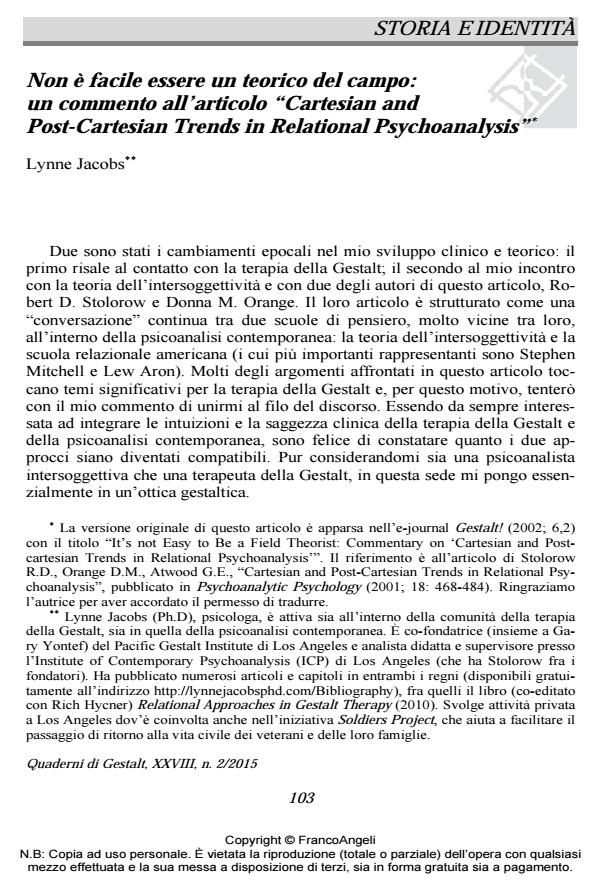It’s Not Easy to Be a Field Theorist: Commentary on "Cartesian and Post-Cartesian Trends in Relational Psychoanalysis"
Journal title QUADERNI DI GESTALT
Author/s Lynne Jacobs
Publishing Year 2016 Issue 2015/2
Language Italian Pages 14 P. 103-116 File size 207 KB
DOI 10.3280/GEST2015-002007
DOI is like a bar code for intellectual property: to have more infomation
click here
Below, you can see the article first page
If you want to buy this article in PDF format, you can do it, following the instructions to buy download credits

FrancoAngeli is member of Publishers International Linking Association, Inc (PILA), a not-for-profit association which run the CrossRef service enabling links to and from online scholarly content.
This article is a commentary written in response to a chapter written by Atwood, Stolorow and Orange, in which they critique some of the ideas of the New York relational psychoanalytic approach. It is written as part of an on-going "conversation" between two closely allied psychoanalysis schools of thought: the intersubjectivity theory and the American relational school (most prominently represented by Stephen Mitchell and Lew Aron), and Gestalt therapy. My commentary tackles the epistemological similarities between Gestalt therapy and contemporary psychoanalysis, and addresses different perspectives on "here and now" and mutual recognition. Furthermore, based on the field-theoretical approach and on the example of some statements by Isadore From, the Gestalt therapy theory of "interruptions of contact" and of contact episodes is critically discussed.
Keywords: Gestalt therapy, relational psychoanalysis, intersubjectivity theory, "here and now", mutual recognition, critique of the "interruptions of contact" theory
- Beisser A. (1970). The Paradoxical Theory of Change. Retrieved from http://gestalttherapy. org/publications/paradoxicaltheoryofchange.pdf
- Benjamin W. (1995). Like Subjects, Love Objects. Yale: New Haven.
- Bergson H. (ed. or. 1910; 1960). Time and Free Will. New York: Harper Torchbooks.
- Culler J. (2003). Sulla decostruzione. Roma: Studi Bompiani.
- Derrida J. (1978). Writing and Difference. Chicago: University of Chicago Press.
- Hersch E. (2001). Making our Philosophical Unconscious More Conscious: A Method of Exploring the Philosophical Basis of Psychological Theory. Canadian Journal of Psychoanalysis, 9, 2: 165-186.
- Kohut H. (1977). The Restoration of the Self. New York: International Universities Press.
- Miller M.V. (2001). What Lies Beyond the Field? In: Robine J.-M., ed., Contact and Relationship in a Field Perspective. Bordeaux: L’Exprimerie, 109-118.
- Mitchell S. (1988). Relational Concepts in Psychoanalysis. Cambridge, MA: Harvard Press (trad. it.: Gli orientamenti relazionali in psicoanalisi per un modello integrato. Torino: Bollati Boringhieri, 1993).
- Müller B. (1995). On Isadore From’s Contribution to Gestalt Therapy. British Gestalt Journal, 4, 2: 121-128 (trad. it.: Il contributo di Isadore From alla teoria e alla pratica della Gestalt Terapia. Quaderni di Gestalt, 1992; 15: 7-23).
- Orange D.M. (1995). Emotional Understanding: Studies in Psychoanalytic Epistemology. NY: Guilford Press (trad. it.: La comprensione emotiva. Roma: Astrolabio, 2001).
- Orange D.M., Atwood G.E., Stolorow R.D. (1999). Intersoggettività e lavoro clinico. Il contestualismo nella pratica psicoanalitica. Milano: Raffaello Cortina.
- Parlett M. (1991). Reflections on Field Theory. British Gestalt Journal, 1, 1: 69-81.
- Parlett M. (1997). The Unified Field in Perspective. Gestalt Review, 1, 1: 16-33.
- Perls F.S., Hefferline R.F., Goodman P. (ed. or. 1951; 1994). Gestalt Therapy: Excitement and Growth in Human Personality. New York: Gestalt Journal Press (trad. it.: Teoria e pratica della terapia della Gestalt. Vitalità e accrescimento nella personalità umana. Roma: Astrolabio, 1971; 1997).
- Polster E. (1998). Translating Theory into Practice: Martin Heidegger and Gestalt Therapy. Gestalt Review, 2, 3: 253-268.
- Roberts A. (1999). The Field Talks Back. British Gestalt Journal, 8, 1: 35-46.
- Robine J.-M. (1997). Is There a Common Ground on Which We Can Build? Gestalt Journal, 20, 2: 7-22.
- Robine J.-M., ed. (2001). Contact and Relationship in a Field Perspective. Bordeaux: L’Exprimerie.
- Spagnuolo Lobb M. (2001). From the Epistemology of Self to Clinical Specificity in Gestalt Therapy. In: Robine J.-M., ed., Contact and Relationship in a Field Perspective. Bordeaux. L’Exprimerie, 49-65 (trad. it.: Il sé che crea ed è creato nel contatto. Teoria classica della terapia della Gestalt. In: Spagnuolo Lobb M. Il now-for-next in psicoterapia. La psicoterapia della Gestalt raccontata nella società post-moderna. Milano: FrancoAngeli, 2011, 66-116).
- Staemmler F.-M. (1993). Projective Identification in Gestalt Therapy with Severely Impaired Clients. British Gestalt Journal, 2, 2: 104-110.
- Stolorow R.D., Atwood G.E. (1995). I contesti dell’essere. Le basi intersoggettive della vita psichica. Torino: Bollati Boringhieri.
- Stolorow R.D., Orange D.M., Atwood G.E. (2001). Cartesian and Post-Cartesian Trends in Relational Psychoanalysis. Psychoanalytic Psychology, 18: 468-484.
- Wheeler G. (2000). Beyond Individualism: Toward a New Understanding of Self, Relationship, and Experience. Hillsdale, NJ: The Analytic Press.
- Yontef G. (1993). Introduction to Field Theory. In: Yontef G., ed., Awareness, Dialogue and Process. Highland, NY: Gestalt Journal Press, 285-325.
Lynne Jacobs, Non è facile essere un teorico del campo: un commento all’articolo "Cartesian and Post-Cartesian Trends in Relational Psychoanalysis" in "QUADERNI DI GESTALT" 2/2015, pp 103-116, DOI: 10.3280/GEST2015-002007